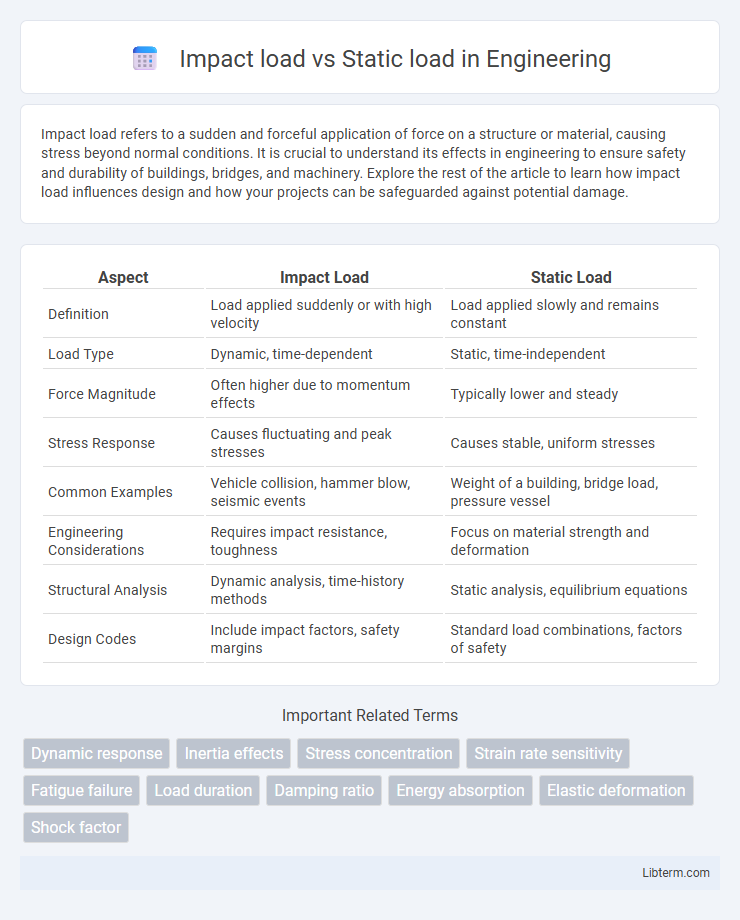Impact load refers to a sudden and forceful application of force on a structure or material, causing stress beyond normal conditions. It is crucial to understand its effects in engineering to ensure safety and durability of buildings, bridges, and machinery. Explore the rest of the article to learn how impact load influences design and how your projects can be safeguarded against potential damage.
Table of Comparison
| Aspect | Impact Load | Static Load |
|---|---|---|
| Definition | Load applied suddenly or with high velocity | Load applied slowly and remains constant |
| Load Type | Dynamic, time-dependent | Static, time-independent |
| Force Magnitude | Often higher due to momentum effects | Typically lower and steady |
| Stress Response | Causes fluctuating and peak stresses | Causes stable, uniform stresses |
| Common Examples | Vehicle collision, hammer blow, seismic events | Weight of a building, bridge load, pressure vessel |
| Engineering Considerations | Requires impact resistance, toughness | Focus on material strength and deformation |
| Structural Analysis | Dynamic analysis, time-history methods | Static analysis, equilibrium equations |
| Design Codes | Include impact factors, safety margins | Standard load combinations, factors of safety |
Introduction to Impact Load and Static Load
Impact load refers to a sudden force or shock applied to a structure or material over a short duration, often causing stress concentrations and potential damage. Static load is a constant or slowly varying force exerted on an object, maintaining equilibrium without causing rapid stress fluctuations. Understanding the differences between impact load and static load is essential for designing resilient structures capable of withstanding dynamic and steady-state forces.
Defining Impact Load: Characteristics and Examples
Impact load refers to a sudden and forceful application of load on a structure or material, characterized by high intensity over a short duration leading to dynamic stress. Unlike static load, which is applied slowly and remains constant or changes gradually, impact loads result from events such as collisions, falls, or explosions, causing rapid deformation. Examples include a hammer striking a nail, a vehicle crash, and a ball hitting a wall, where the load intensity and time variation significantly affect design considerations in engineering.
Static Load: Meaning and Practical Applications
Static load refers to a force or weight applied slowly and steadily to a structure without causing motion or acceleration, ensuring consistent pressure over time. It is critical in engineering for evaluating the strength and stability of buildings, bridges, and machinery under constant weights such as furniture, equipment, or building materials. Practical applications include foundation design, load-bearing wall assessment, and the calculation of floor load capacities to prevent structural failure and ensure safety.
Fundamental Differences: Impact Load vs Static Load
Impact load involves forces applied suddenly or dynamically, causing high stress concentrations and potential material deformation or failure, whereas static load refers to forces applied slowly and remain relatively constant over time, allowing structures to respond with elastic deformation. Impact loads often induce vibrations, shock waves, and transient stresses, while static loads produce steady-state stress distribution within materials. Understanding these fundamental differences is crucial for designing structures and materials to withstand dynamic impacts versus prolonged static pressures effectively.
Structural Response to Impact Loads
Impact loads cause sudden, high-magnitude forces that induce dynamic structural responses such as stress waves, localized deformation, and potential material failure. Unlike static loads, which apply consistent pressure, impact loads generate rapid strain rates leading to increased stress concentrations and possible brittle fracture. Engineering analysis must account for energy absorption, damping properties, and strain-rate sensitivity to predict structural behavior under impact conditions accurately.
Material Behavior Under Static Loads
Material behavior under static loads involves deformation and stress distribution that occur gradually over time, allowing materials to reach a stable equilibrium state. Unlike impact loads, which cause sudden stress and potential localized damage, static loads induce consistent strain, enabling accurate analysis of elastic and plastic deformation. Understanding static load responses is crucial for designing structures to withstand long-term forces without failure.
Design Considerations for Impact and Static Loads
Design considerations for impact loads require evaluating dynamic forces that can cause sudden stress and potential material deformation, emphasizing the need for materials with high toughness and energy absorption capacity. Static load design focuses on sustained forces, necessitating the selection of materials with adequate yield strength and stability under prolonged stress to prevent creep or fatigue. Engineers must implement safety factors, perform dynamic analysis for impact loads, and conduct stress-strain assessments for static loads to ensure structural integrity and longevity.
Common Engineering Failures: Impact Load vs Static Load
Common engineering failures caused by impact loads occur due to sudden, high-magnitude forces that exceed material strength, leading to cracks, fractures, or deformation. Static load failures result from prolonged stress causing material fatigue, creep, or buckling over time, often seen in structures under constant weight. Understanding the differences between impact and static load responses in materials like steel, concrete, and composites is critical for designing safe, durable engineering systems.
Testing Methods for Impact and Static Load Effects
Testing methods for impact load effects primarily involve drop weight tests, pendulum impact machines, and high-strain rate loading to simulate sudden forces and assess material behavior under dynamic conditions. Static load testing uses equipment such as universal testing machines applying gradually increasing forces to measure deformation and strength under steady-state conditions. Accurate evaluation requires selecting appropriate strain gauges, high-speed data acquisition systems for impact testing, and extensometers for static tests to capture precise load-deformation responses.
Conclusion: Selecting Appropriate Load Criteria
Selecting appropriate load criteria depends on the nature of the applied forces and their effects on materials or structures. Impact loads cause sudden, high-intensity forces that require designs accounting for dynamic stress, strain rate sensitivity, and energy absorption capacity. Static loads apply steady forces, allowing for simpler stress analysis based on equilibrium and material yield strength, thus making impact load considerations critical in safety and durability assessments for structures exposed to dynamic conditions.
Impact load Infographic

 libterm.com
libterm.com